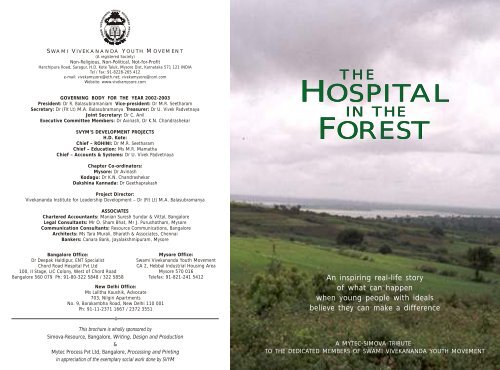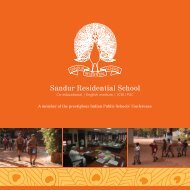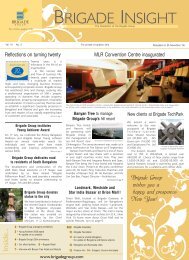SVYM - Resource Communications Pvt. Ltd
SVYM - Resource Communications Pvt. Ltd
SVYM - Resource Communications Pvt. Ltd
You also want an ePaper? Increase the reach of your titles
YUMPU automatically turns print PDFs into web optimized ePapers that Google loves.
IKEAWSMENTSORENADAYOUTHMOVEANIVVMYMSWAMI VIVEKANANDA Y OUTH MOVEMENT(A registered Society)Non-Religious, Non-Political, Not-for-ProfitHanchipura Road, Saragur, H.D. Kote Taluk, Mysore Dist, Karnataka 571 121 INDIATel / Fax: 91-8228-265 412e-mail: vivekamysore@eth.net; vivekamysore@vsnl.comWebsite: www.vivekamysore.comGOVERNING BODY FOR THE YEAR 2002-2003President: Dr R. Balasubramaniam Vice-president: Dr M.R. SeetharamSecretary: Dr (Flt Lt) M.A. Balasubramanya Treasurer: Dr U. Vivek PadvetnayaJoint Secretary: Dr C. AnilExecutive Committee Members: Dr Avinash, Dr K.N. Chandrashekar<strong>SVYM</strong>’S DEVELOPMENT PROJECTSH.D. Kote:Chief – ROHINI: Dr M.R. SeetharamChief – Education: Ms M.R. MamathaChief – Accounts & Systems: Dr U. Vivek PadvetnayaT H EOH SPITALIN THEF ORESTChapter Co-ordinators:Mysore: Dr AvinashKodagu: Dr K.N. ChandrashekarDakshina Kannada: Dr GeethaprakashProject Director:Vivekananda Institute for Leadership Development – Dr (Flt Lt) M.A. BalasubramanyaASSOCIATESChartered Accountants: Manian Suresh Sundar & Vittal, BangaloreLegal Consultants: Mr O. Sham Bhat, Mr J. Purushotham, MysoreCommunication Consultants: <strong>Resource</strong> <strong>Communications</strong>, BangaloreArchitects: Ms Tara Murali, Bharath & Associates, ChennaiBankers: Canara Bank, Jayalakshmipuram, MysoreBangalore Office:Dr Deepak Haldipur, ENT SpecialistChord Road Hospital <strong>Pvt</strong> <strong>Ltd</strong>100, II Stage, LIC Colony, West of Chord RoadBangalore 560 079 Ph: 91-80-322 5848 / 322 5858New Delhi Office:Ms Lalitha Kaushik, Advocate703, Nilgiri ApartmentsNo. 9, Barakambha Road, New Delhi 110 001Ph: 91-11-2371 1667 / 2372 3551Mysore Office:Swami Vivekananda Youth MovementCA 2, Hebbal Industrial Housing AreaMysore 570 016Telefax: 91-821-241 5412An inspiring real-life storyof what can happenwhen young people with idealsbelieve they can make a differenceThis brochure is wholly sponsored bySimova-<strong>Resource</strong>, Bangalore, Writing, Design and Production&Mytec Process <strong>Pvt</strong> <strong>Ltd</strong>, Bangalore, Processing and Printingin appreciation of the exemplary social work done by <strong>SVYM</strong>A MYTEC-SIMOVA TRIBUTETO THE DEDICATED MEMBERS OF SWAMI VIVEKANANDA YOUTH MOVEMENT
The People of the Forest...MUMBAI(BOMBAY)The remote forests around the Kabini river were home toseveral unique groups of tribals: the Jenukurubas, Kadukurubas,Paniyas, Yeravas and Soligas. From time immemorial, they hadmade a livelihood through hunting, shifting agriculture and thegathering of minor forest produce.Their lifestyles were utterly simple. They lived for the day athand, with no thought of tomorrow. Each group had its owncustoms, traditions and culture. They took no dowry. No widowwas ostracized, no child uncared for. There was no concept ofindividual ownership. In its stark simplicity, it was an idyllicexistence.Their life changed dramatically in the 1960s, when theirhabitat was submerged under the waters of the Kabini reservoirand they were forced to move. Ten years later, their newwandering grounds were declared a protected area under‘Project Tiger’, which aimed at saving this threatened species.And once again they were evicted. On neither occasion werethey suitably compensated or viably relocated.BANGALOREMYSORECHENNAI(MADRAS)Vir a jp et t a lukMETIKUPPEFORESTKAKANAKOTEFORESTManan davadiRdHeggadadevanakoteTARAKARIVERKABIN I RIVERBrahmagiriHosahalliKABINIDAMHunsur talukKenchanahalliSaragurNUGUDAMWayNtoUGMysoreURIVERMyso r e t al ukNanjan g ud talukK E R A L AA tribal familyBEGURFORESTAINURMARIGUDIFORESTGundlupet talukLiving in small settlements called haadis, they had no accessto the forests that had provided them the only living they knew.In this unfamiliar, inhospitable environment, they were not onlyeconomically stricken, but socially alienated too. Malnutrition,illiteracy and under-development threatened their very survival.The comfort of the past was closed to them. They could notfit into mainstream society. And yet,unless they could assimilate, they weredoomed.A tribal haadi
IOut-patient ClinicWaytoMysoreSwami Vivekananda1863-1902Outstanding thinkerand humanitarian of19th century India,who gave a clarioncall to the sleepingnation to, "Arise !Awake ! Stop not tillthe goal is reached ".KAIVEVMAWSNANDAYIt all began when a group of medical students at MysoreMedical College became increasingly aware that the career inmedicine they dreamed of pursuing was very different from thepractice of medicine around them.And so the Swami Vivekananda Youth Movement (<strong>SVYM</strong>), avoluntary organization, was born. Its initial assets were highideals and all the positive benefits of inexperience. The yearwas 1984.They made a modest beginning by supplying physician’ssamples to poor patients, arranging for blood and providingcounselling. <strong>SVYM</strong> then moved on to running weekly ruralclinics.OUTHMNON-POLITICALNON-RELIGIOUSNOT-FOR-PROFIT...and the doctors who came their wayAnd then, in 1987, destiny brought the doctors toHeggadadevanakote (H.D. Kote) Taluk, one of the mostbackward taluks in Karnataka state—the home of the displaced,dispossessed tribals.<strong>SVYM</strong> set up a primary health clinic at Brahmagiri, in themidst of the tribal colony. The local Zilla Panchayath (DistrictCouncil) loaned them a building, a local family gave them acow. The doctors spent their days clearing the building of weedsand carrying out repairs. At times they slept in empty waterpipelines. Bad roads and tough living conditions made it allharder.OVEMENTMYSOREAppreciative of their work and perseverance, theDeputy Commissioner of Mysore granted them fiveacres of land at Hosahalli. Their lives, and those ofthe tribals, were now irreversibly linked.As time passed, <strong>SVYM</strong> realised thathealthcare was just one aspect of bettering thetribals' lives. Sustained enrichment could beachieved only through education, a steadyearning and saving capacity, a broader socialoutlook and a realisation by the tribals that theirtomorrow could be better than their today.The rural poor of H.D. Kote taluk lived incircumstances often as pathetic as that of thetribals, and were as much in need of help. Increasingly, <strong>SVYM</strong>'sViveka Tribal Centrefor LearningFirst to Tenth Standard;More than 400 students,residential and day-scholarsMETIKUPPEFORESTManan davadiCommunity DevelopmentCentre for TribalsAgricultural and vocationaltraining for tribal men and womenHeggadadevanakoteZone 4TARAKARdRIVERZone 3KABINI RIVERZone 1KENCHANAHALLIBrahmagiriHOSAHALLIBEGURFORESTKABINIDAMAINURMARIGUDIFORESTSARAGURNUGUDAMassistance was required by a greater number of people in moreand different ways.<strong>SVYM</strong> began by setting up a small, 10-bed hospital atKenchanahalli. They soon realised that the greatest need thecommunity faced was easy access to a dependable, high-qualitymulti-specialty hospital. At the time, people had to travel toMysore for specialised medical care. Limited transportation andcommunication facilities made it a very difficult journey.The 60-bed Vivekananda Memorial Hospital at Saragurwas completed in 2002, with a tremendous amount of localsupport at every stage of its creation. With a full-fledgedoperation theatre, ICU and multi-specialty services, it canprovide comprehensive healthcare to the 2,50,000 population ofH.D. Kote and beyond. Mobile Health Units augment theservices and reach provided by the hospital. A simultaneousfocus on community health has helped raise public awarenessand given true meaning to the idea of comprehensivehealthcare.The Viveka Tribal Centre for Learning, a semi-residentialschool at Hosahalli, provides modern education to over 400tribal children. The Viveka School of Excellence has recently beenstarted at Saragur. In addition, a consortium of over 321government schools brings a large number of children andteachers into the ambit of <strong>SVYM</strong>'s activities.Community Development Programmes—aimed atcreating self-sufficiency through pooled resources, networkingand education—are constantly being developed, refined andpromoted.Zone 5HANDPOSTZone 6Zone 2NUGUVivekanandaMemorial Hospital60–bed hospitalRIVERVivekanandaMemorial Hospital10-bed hospitalH.D. Kote taluk has been divided into six zones to make administration and operations more effective.<strong>SVYM</strong> has also opened new centres at: Mysore City (H.Q of Mysore Dist, 50 km north-east of Saragur);Gonikoppal (45 km north-west of Saragur) to serve Kodagu Dist; and Vittla (170 km north-west ofSaragur) to serve Dakshina Kannada.“.... So long as themillions die in hungerand ignorance, I holdevery man a traitorwho, having beeneducated at theirexpense, pays not theleast heed to them !— Swami Vivekananda1863 –1902”
<strong>SVYM</strong>'s hospital at Kenchanahalli<strong>SVYM</strong>'s hospital at Saragurand networks with different institutions in specific areas likeoncology and cardiac care.<strong>SVYM</strong> also facilitates networking of the existing healthinfrastructure (primary health centres, rural dispensaries andprivate clinics) and creates new centres where there arenone.Vivekananda Memorial Hospital: In addition to the10-bed hospital at Kenchanahalli, <strong>SVYM</strong> has set up theVivekananda Memorial Hospital at Saragur. The 60-bedhospital with multi-disciplinary specialist services has beendesigned and developed to provide reliable, affordableinstitutional care of a very high order. The hospital hassurgical, trauma, emergency and critical care services,with the requisite diagnostic back up. It is increasinglybeing recognised as a referral centre.As the well being of women and children is vital tothe well being of the community, <strong>SVYM</strong> places a specialemphasis on Reproductive and Child Healthcare.Vital Communication Links: Communication is possiblefrom every corner of the taluk, thanks to the linking of<strong>SVYM</strong>'s medical centres, ambulances and field workersthrough wireless sets.A functioning telemedicine unit atboth the Kenchanahalli and Saragurhospitals provides invaluable locationfree,real-time audio-video conferencingfacilities. This facility allows <strong>SVYM</strong> toaccess medical opinion from all over theworld—and to provide their consultancyservices wherever and whenever needed. Through thetelemedicine facility, <strong>SVYM</strong> can also upgrade the skills ofits doctors, nurses and healthcare personnel.Education Related InitiativesViveka Tribal Centre for Learning (VTCL), Hosahalli:Initially, <strong>SVYM</strong>'s most important task was to make thetribals and rural poor of H.D. Kote appreciate the valueof education. <strong>SVYM</strong> then began to create a model ofalternate education focusing on the middle class andrural communities. If students wish to study further, thiswould ensure that their transition to a mainstreameducational institution is as painless as possible.The VTCL began as a thatched hut with a fewstudents. Today, it is a government-recognised, semiresidentialschool imparting education to over 400children. A primary aim is to help these children fit intothe mainstream while retaining pride in, and contactwith, their tribal heritage.The VTCL trains teachers from other schools, developsteaching aids and enhances children's lives throughinnovative educational methods like joyful learning,experiential learning and activity-based learning.Telemedicine facilitiesClassrooms, VTCLInside a classroomPathology lab, SaragurRegistration at Saragur HospitalLibrary, VTCLSchool excursion, VTCLMobile Health UnitOperation theatre, SaragurSpecialist services, SaragurAgriculture, VTCLDining Hall, VTCL
Prayer time, Viveka School of Excellence“For the first time,we have forgottenour differences andare aware of ourcollective strength.”— Moodalimadiah,Kadukuruba Yajamana(Chieftain) of JaganakotehaadiEducation about the paddy productionA consortium of over 321 governmentschools has been formed withthe intention of improving the qualityof education amongst its 43,000students. Educational RecreationExperiential learning, VTCLCentres have been set up at manyvillages and awareness is being spread through CommunityFacilitators.Viveka School of Excellence, Saragur: Inspired by thesuccess of VTCL, <strong>SVYM</strong> has set up another school atSaragur based on the same innovative principles ofeducation. The Viveka School of Excellence is open tonon-tribals.Non-formal Education (NFE) Programmes:<strong>SVYM</strong> has set up six NFE centres, targeted at preschoolers(under six), in the primitive Jenukurubacolonies. The focus is on creating awareness about education.Vidya Vahini: The purpose of Vidya Vahini is to spreadeducation—through a bus modified to serve as a mobile'edutainment' school. The project is run largely by formerstudents of VTCL.Community Development Initiatives<strong>SVYM</strong> had observed that existing social welfare schemes,though well-intentioned, spawned a sense of dependence ratherthan self-reliance. People hopped from the cocoon-like security ofone training programme into that of another. The skills learnedalong the way were not utilised to earn a livelihood. For peopleto benefit, they would have to feel a sense of personal involvementin the programme—right from the conceptualizingstage—and realize their efforts to make it a success directlyaffected their future. <strong>SVYM</strong> has tailored its role accordingly. Frombeing a provider of services, it is now a promoter-facilitator.<strong>SVYM</strong> has networked with other government andnon-government organizations with expertise in the fieldsof agriculture, soil and water management, sanitation,housing and community organization. The focus ofcommunity development services today is in linking thecommunity directly to these network partners.In an effort to promote self-relianceand sustainability, a local people'sorganization has been formed togradually play a nodal role in thecommunity's development. The JagruthaBharatha programme, for instance, hashad an enormous influence in creating positive change. Underthis programme, staff and volunteers enact street plays andperform skits and songs concerning health, education, socialissues and ideas like banking and public distribution systems.Water sanitation and hygiene educationTo promote awareness of these concepts, a newsletter,Vivekavani, has been started, which is becomingincreasingly popular.<strong>SVYM</strong>'s experiences and knowledge in the developmentsector have been carefully documented. Thisinformation is being shared, through trainingprogrammes, with other NGOs/GOs working in similarareas. By functioning as consultants, <strong>SVYM</strong> hopes tofacilitate the spread of its core competencies, for thegreater good of a larger number of people.Vivekananda Institute for LeadershipDevelopment (VILD)VILD serves as a one-stop shop for honing individualand institutional capacities in diverse fields related tothe development Sector, through training, advocacy,research and consultancy. It aims at ensuring betterprogramme planning, implementation and managementof programmes leading on to 'Sustainable Process ofDevelopment' in a larger geographical area. The trainingmethodology consists of seminars, workshops, symposiums,field exposures, interactive sessions, focusedgroup discussions and participative mock exercises.It is becoming increasingly apparent that salvationfor the underprivileged of H.D. Kote lies in educatedself-reliance. The sad fact is that there are many H.D.Kotes, in India and all over the world, each one ofthem in need of upliftment. <strong>SVYM</strong> hopes that morespin-off groups, greater networking and the activeparticipation of more and more inspired people, willmake a better life for the dispossessed a reality.Self-help groupsSericultural activityJagruta Bharata
Please HelpWhile the commitment and spirit of <strong>SVYM</strong>’s members remainsundiminished by time or changing circumstances, they cannotcontinue as they hope to without funding.The need for new facilities is growing, and money is desperatelyrequired to meet these needs. As roads are primitive inparts, <strong>SVYM</strong>'s few vehicles break down with devastating regularityat the most essential times. Medical equipment breaks downtoo. Repair charges add up to worrisome amounts. Children atschool need to be fed day after day after day. Accidents happen,pregnant women need care, patients of all ages cannot dowithout treatment or medicines. Community developmentprojects have to begin or continue, for in their potential toexpand horizons and create self-sufficiency lies the real hope forHeggadadevanakote's poor. So do medical research projects,which may ultimately hold the key to a healthier generation.Sometimes everything, including morale and hope, is inpainfully short supply.To date, funding has come from both caring individuals aswell as public and private agencies.While their generosity and assistance have been invaluable,their continued support cannot be taken for granted.Contributions from most agencies are bound by term-limits. Somuch of <strong>SVYM</strong>'s funding will expire in the near future.Anything you can give will make a tremendousdifference.It could be a monetary contribution: You couldspecify where you want the money used or leave it to <strong>SVYM</strong> todisburse, based on priority and need. You could request that yourcontribution be used to perpetuate the memory of a loved one,such as a scholarship bearing his or her name. Or your contributioncould be in memory of a milestone in your life.It could be in kind: Through a product or service you canoffer. Or expertise in medicine, education, agriculture, managementor any relevant area of specialization. Or organizationalskills that may benefit <strong>SVYM</strong>. They would be deeply grateful forany personal involvement from you.Donations made to <strong>SVYM</strong> are tax deductible in Indiaunder Section 35 AC (for corporates and professionals) andSection 80 (G) (for individuals) of the Indian Income Tax Act.Cheques / DD's may be sent to:Swami Vivekananda Youth MovementHanchipura Road, Saragur, H.D. Kote Taluk,Mysore Dist, Karnataka 571 121 INDIATel / Fax: 91-821-245412Contribution to <strong>SVYM</strong> in USA can be forwarded toSwami Vivekananda Youth Movementof North America2832, Alderberry Ct., Fullerton, CA 92835Ph: 011-714-674-0105e-mail: svymofna@aol.comEIN-02-0687246(<strong>SVYM</strong>’s administrative costs do not exceed 6% of theproject costs. Audited financial statement and activity reportavailable on request.)<strong>SVYM</strong> is registered:•under Karnataka Societies Registration Act, vide No. 122 / 84-85 dated 1-12-1984.•with Ministry of Home Affairs, Government of India, under FRCA 1976 vide No. 094590102.•with Ministry of Welfare under the Indo-US bilateral agreement vide No. 17-7 / 95-NI-Idated 22-12-97 to receive foreign goods.















